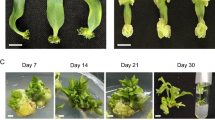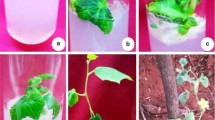Abstract
The total duration of the plant regeneration process from cucumber (Cucumis sativus L.) cotyledonary explants was only six weeks, which included the induction of buds and their development into plants. Regeneration of shoots from cotyledons from three to five day-old seedlings ranged up to 100%. The regenerated plants were morphologically normal, flowered and set seed. The regeneration capacity of cotyledons from seven days-old and older seedlings was lowered dramatically. Most of those regenerated plants were polyploid/mixoploid and had an abnormal morphology. During seedling development (3 to 13 days), the DNA content of cotyledonary cells changed from 2C to 4C and more. The results show that the decrease in regeneration competence correspond with the change in DNA content of the cotyledonary cells.
Similar content being viewed by others
References
Colijn-Hooymans C M, Bouwer R, Orczyk W & Dons J J M (1988) Plant regeneration from cucumber (Cucumis sativus L.) protoplasts. Plant Science 57: 63–71
Coutos-Thevenot P, Jouanneau J P, Brown S, Petiard V & Guern J (1990) Embryogenic and non-embryogenic cell lines of Daucus carota cloned from meristematic cell clusters; relation with cell ploidy determined by flow cytometry. Plant Cell Rep. 8: 605–608
D'Amato F (1985) Cytogenetics of plant cell and tissue cultures and their regenerates CRC. Crit. Rev. Plant Science 3: 73–112
Den Nijs A P M & Custers J B M (1990) Introducing resistances into the cucumber by interspecific hybridization. In: D M Bates (Ed) The Biology and Chemistry of the Cucurbitaceae (pp 382–396). Cornell University Pres, Itaca New York
Evans L S & Van 't Hof J (1985) Is polyploidy necessary for tissue differentiation in higher plants. American Journal of Botany 62: 1060–1064
Galbraith D W, Afonso C L & Harkins K R (1985) Flow sorting and culture of protoplasts: Conditions for high frequency recovery, growth and morphogenesis from sorted protoplasts of suspension cultures of Nicotiana. Plant Cell Rep. 3: 151–155
Gambley R L & Dodd W A (1990) An in vitro technique for the production de novo of multiple shoots in cotyledon explants of cucumber (Cucumis sativus L.). Plant Cell Tiss. Org. Cult. 20: 177–183
Gambley R L & Dodd W A (1991) The influence of cotyledons in auxillary and adventitious shoot production from cotyledonary nodes of Cucumis sativus L. (cucumber). Journal of Experimental Botany 42: 1131–1135
Gilissen L J W, Van Staveren M J, Creemers-Molenaar C & Verhoeven H A (1993) Development of polysomaty in seedlings and plants of Cucumis sativus L. in vitro. Plant Sci. 91: 171–179
Karp A (1991) Oxford surveys of plant molecular and cell biology In: Migglin B J (Ed) On the current understanding of somaclonal variation Vol 7 (pp 1–58). Oxford University Press in cooperation Grith the International Society for Plant Molecular Biology (ISPMB)
Koornneef M, Hanhart C J & Martinelli L (1987) A genetic analysis of cell culture traits in tomato. Theor. Appl. Genet. 74: 633–641
Malepszy S (1988) Cucumber (Cucumis sativus L.) Bajaj Y P S (Ed) Biotechnology in Agriculture and Foresty, Vol 6, Crops II (pp 277–293). Springer-Verlag Berlin Heidelberg
Mc Cullagh P & Nelder J A (1989) Generalized linear models (2nd ed.) London: Chapman and Hall
Murashige T & Skoog F (1962) A revised medium for rapid growth and bioassays with tobacco tissue culture. Physiol. Plant. 51: 473–497
Nagl W (1990) Gene amplification and related events. In: Bajaj Y P S (Ed) Biotechnology in Agriculture and Forestry, Vol II. Somaclonal Variation in Crop Improvement I (pp 153–201). Springer, Berlin, Heidelberg, New York
Nuti Ronchi V, Mozzolini M & Avanzi L (1981) Chromosome variation on plant regenerated from two Nicotiana species. Protoplasma 109: 433–444
Payne R W & Lane P W (1987) Genstat 5 Reference Manual Oxford. Oxford University Press
Pijnacker L P, Sree Ramulu K, Dijkhuis P & Ferwerda M A (1989) Flow cytometric and karyological analysis of polysomaty and polyploidization during callus formation from leaf segments of various potato genotypes. Theor. Appl. Genet. 77: 102–110
Sang-Gu K, Joeng-Rahn C, Heijon Cheol C & Kwang-Woong L (1988) Callus growth and plant regeneration in diverse cultivars of cucumber (Cucumis sativus L.). Plant Cell Tiss. Org. Cult. 12: 67–74
Scharpé A & Van Parijs R (1973) The formation of polyploid cells in ripening cotyledons of Pisum sativum L. in relation to ribosome and protein synthesis. Journal of Experimental Botany 24: 216–222
Sree Ramulu K & Dijkhuis P (1986) Flow cytometric analysis of polysomaty and in vitro genetic instability in potato. Plant Cell Rep. 3: 234–237
Trulson A J & Shahin E A (1986) In vitro plant regeneration in the genus Cucumis. Plant Science 47: 35–43
Wehner T C & Locy R D (1981) Hort Science, In vitro adventitious shoot and root formation of cultivars and lines of Cucumis sativus L. Hort Science 16 (6): 759–760
Zagorska N A, Shamina B Z & Butenko R G (1974) The relation-ship of morphogenic potency of tobacco tissue culture and its cytogenic features. Biol. Plant. 16: 262–274
Ziv M & Gadasi G (1986) Enhanced embryogenesis and plant regeneration from cucumber (Cucumis sativus L.) callus by activated charcoal in solid/liquid double-layer cultures. Plant Science 47: 115–122
Author information
Authors and Affiliations
Rights and permissions
About this article
Cite this article
Colijn-Hooymans, C.M., Hakkert, J.C., Jansen, J. et al. Competence for regeneration of cucumber cotyledons is restricted to specific developmental stages. Plant Cell Tiss Organ Cult 39, 211–217 (1994). https://doi.org/10.1007/BF00035972
Received:
Accepted:
Issue Date:
DOI: https://doi.org/10.1007/BF00035972




